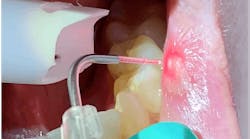Smart technology to the rescue during COVID-19
By Brian D. Vancil, DMD
COVID- 19 has had a profound effect on the delivery of all health services, including dental care. Despite practices reopening and steadily increasing capacity, there are new instructions and protocols for COVID-secure environments that have dramatically changed how dental offices are being run.
My office was forced to shut down in March, with appointments limited to emergency procedures. As a result, we ran at about 10% capacity. Since then, appointments and procedures have been steadily picking up. However, we’re working in an environment and facing challenges that dental school didn’t prepare us for. Patients returning to us can expect significant differences in the required safety procedures, not just from the dentist, but also in how they interact in the practice.
The new health and safety
Due to dentists working with open-mouthed patients for extended periods of time and the infection risks associated with aerosol-generated procedures, dentistry is a risky environment. This has led to key health and safety changes being reevaluated.
Dentists are wearing more layers of personal protective equipment (PPE), and changing their face masks, gloves, face shields, gowns and jackets between every appointment. They also spray and clean the room thoroughly between every patient to ensure that potentially dangerous particles don’t linger in the air. While these sound like easy solutions, dental offices are struggling to access and afford the necessary amount of PPE due to continued high demand from both health-care professionals and the public.
As a result, our costs are rising. For example, it cost me nearly $15,000 to reopen one office due to the need for expensive upgrades in areas such as air conditioning, medical-grade air purifiers, and UV light on air conditioners. These time-consuming decontamination processes and extensive PPE measures have dramatically reduced the number of patients that can be treated in a day. My offices are currently running at 75%–80% capacity, so I’m still seeing fewer patients per day in order to lower risks and contact points. This means fewer patients but increased costs.
The digital upgrade
Many dental offices are turning to technology to help alleviate some of the pressures as they transition to new health and safety regulations. For example, recent developments in smartphone cameras and dental apps, part of a growing category of smart dental solutions, means that the assessment component of dental care can be completed through the use of devices such as smartphones rather than through face-to-face contact.
Of course, to have a full consultation I would need access to an x-ray machine, which isn’t possible through a phone. However, one of the key factors when managing dental offices during COVID-19 is limiting interaction and having patients in the office for as short a time as possible.
So, if I can have a virtual consultation before someone even enters the office, I save chair time and treat more people in the working day. Through simply seeing pictures taken on smartphones, I gain a good understanding of what treatment must be done before someone even walks through the door. This is more important during the pandemic as it limits the risk of transmission while saving time and resources for both the patient and me.
This is a real advantage for patients as they can get clinical recommendations from a licensed dentist on any dental issue from the safety of their own home. I’ve seen more and more live communication on these apps as it offers personalized health care and a one-stop-shop for consumers, providing quick answers to their problems effectively and safely. I’m excited to see how these solutions evolve to reach even more patients and become even more valuable to our practices.
Brian D. Vancil, DMD, graduated from Georgia School of Dentistry and completed his education in general dentistry at the University of Florida. He is currently working toward Diplomate status. He owns and runs a number of dental offices in Georgia. Dr. Vancil works with Toothpic, which remotely provides patients with dental advice with a touch of a smartphone button. Dr. Vancil conducts virtual consultations and reviews images taken by patients to instantly provide advice or organize an appointment.






